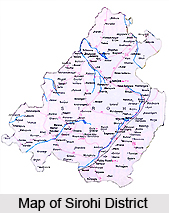 The Sirohi city is the administrative headquarters of Sirohi District, and was formerly the capital of the princely state of the same name. Nearest railway station of the district is Sirohi road station. Except the fairs and festivals Sirohi paintings are very famous in all over the world.
The Sirohi city is the administrative headquarters of Sirohi District, and was formerly the capital of the princely state of the same name. Nearest railway station of the district is Sirohi road station. Except the fairs and festivals Sirohi paintings are very famous in all over the world.
The Name Sirohi had been derived by "Siranwa" hills on the Western Slope of which it stands. Colonel Tod in his book "Travels in Western India" has suggested that the names of the territory might have derived from its position at the head (Sir) of the desert (Rohi), Sirohi also named as "Sword" and this had led some people to believe that this State of brave Deora Chauhans received its present name due to its wide spread fame of its Swords.
History
The state of Sirohi was founded by the Deoras, a branch of the Chauhan clan of Rajputs. Rao(the Hindi title is a variation of Raja) Deoraj, founder of the dynasty, claimed descent from Prithviraj III, the last Hindu ruler of Delhi. In 1405, Rao Sobhaji founded the town of Shivpuri on the western slope of Siranwa Hill. Shivpuri today lies in ruins. In 1425, his son and successor, Sehastramal founded a fortress on the eastern slope of the same hill, which became his capital and grew into the present-day town of Sirohi.
During the early years of the 19th century, Sirohi suffered much from wars with Jodhpur and the Meena hill tribes of the area. The protection of the British was sought in 1817, the pretensions of Jodhpur to suzerainty over Sirohi were disallowed, and in 1823 a treaty was concluded with the British government. Sirohi became a self-governing princly state within British India, and part of the Rajputana Agency.For services rendered during the Revolt of 1857, the Rao received a remission of half his tribute.
The state was traversed by the Rajputana Railway in the 19th century, and a station was built at Abu Road 28 miles south of the town of Sirohi. Rao Keshri Singh (ruled 1875-1920) and his successors were granted the title Maharao (equivalent to Maharaja) in 1889.
With the independence of India in 1947 the process of integration of princely states of India started. The Sirohi state was merged on 16th Nov. 1949 with Rajasthan State.
Geography
Sirohi is bounded by district Pali in the northeast, district Udaipur in east, Jalore in west and Banaskantha district of Gujarat in the south. The total geographical area of the district is 5139 sq. kms.Sirohi is located at 24° 20` and 25° 17` North Latitude and 72° 16` and 73° 10` East Longitude.
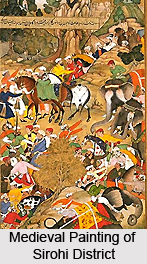 Sirohi has an area of 5139 kms (2009 sq. miles) and is the third smallest district of Rajasthan. It is the third smallest district of Rajasthan, after Dungarpur and Banswara. The average rainfall of the district is 735 mm. The maximum temperature is 47°C. The average temperature is 23°C. The Average Humidity is 62. The main rivers are Jawai, Sukhadi, Khari, Bodi, Krishnavati, Kapalganga, and Banas.
Sirohi has an area of 5139 kms (2009 sq. miles) and is the third smallest district of Rajasthan. It is the third smallest district of Rajasthan, after Dungarpur and Banswara. The average rainfall of the district is 735 mm. The maximum temperature is 47°C. The average temperature is 23°C. The Average Humidity is 62. The main rivers are Jawai, Sukhadi, Khari, Bodi, Krishnavati, Kapalganga, and Banas.
Economy
The Sirohi district had been declared as Industry less district of the Rajasthan in April 1983. At that time the 1574 Industries Units were registered. These had given employment to 3314 persons of the district. Agricultural, Forest, Mechanical, Textile and Animal husbandry were the main among those industries.
Today, there are 8 Large Scale Industries and 12 Medium Scale Industries, and 2,982 Small Scale industries in the district. The Sirohi district is full of minerals therefore the industries based on minerals were developed rapidly. These industries produce Portland cement, Synthetics Yarn, High Tension Insulators, Tirupati Fibers, R.P.R.L. Marble, Granite, Polymers and mineral powder. Similarly, medium scale industries produce tiles and slabs of cement, marble and granites, H-acid, I.R.W tubes, HDPE. Wooven checks and texturizing threads.
The main crops of the Sirohi are Millets, Pulses, Sesame, and Red chillies.
Government
A Collector belongs to an officer of Indian Administrative Service, is the head of the Sirohi. Two Additional District Magistrates help him to serve as administrative head.
The Superintendent of police, an officer belonging to the Indian Police Service, is responsible for maintaining law and order in the district.
Division
Sirohi district has three sub-divisions Sirohi district has three sub-divisions. They are Sirohi, Reodar, and Mount Abu. These three sub-divisions are divided into five Tehsils and they are Sirohi, Sheoganj, Aburoad, Pindwara and Reodar. Also there are three sub-tehsils- Bhavri in Pindwara, Kalandri in Sirohi and Mandar in Reodar tehsils respectively.
Demographics
As per 2001 Census, Sirohi had a population of 35,531. Males constitute 53% and females 47% of the population. 14% of the population is under 6 years of age.
Sirohi has an average literacy rate of 66%, higher than the national average of 59.5%: male literacy is 76%, and female literacy is 54%.
Culture
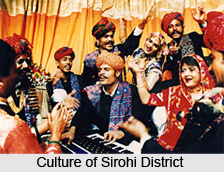 Folk Songs and Folk dances are the traditional way of amusement and entertainment of the people of Sirohi. These folk songs and dances are means of expressing their feelings.
Folk Songs and Folk dances are the traditional way of amusement and entertainment of the people of Sirohi. These folk songs and dances are means of expressing their feelings.
Some of the examples of the marriage folk songs are Mayra Song, Song sung for the bride/ bridegroom called songs of Banada and song of Toran.
In which Mayra song is sung when the brother arrives to his sister`s house for attending his nephews marriage and it express the feelings of the sister for her brother.
Toran Song is sung when the Bride arrives to bridegrooms house with barat procession and reach to the gate of the house of the bridegroom, this may be considered to be the first step of commencing the marriage ceremony.
On the fortnight of the marriage, special type of folk dances and folk songs are organized and these are called Marat Nachna. The males and females perform solo & group dances till late night. On these occasions there is also a fashion of performing Sarkali and Gavri dance.
On the occasion of the Dhajeri Gyaras fair is organized in Sarneshwar Temple. This fair is only for the Rabbari caste and people of other castes are not allowed to enter in the temple for that particular day. It is essential for Rabbaries to wear their traditional dresses. The males and females sings and dances for the whole day and in the night the women sings and the men see dance of Oriya. The Oriya is a folk dancer from Kheda caste and performs dances on these occasions.
The Gacchi Ghodi dance is very attractive dance performed by the tribal people, in which a costume is wear by man and it looks as if the man is sitting on a horse.
On yhe occasion of navratri, Garva dance is performed by men and women with colourful costumes.
Fairs and Festivals of Sirohi district are-
Revadi Fair
Sirohi is surrounded and influenced by three traditional cultures, Marwar, Mewar and Gujarat. So, its festivals and fairs are colourful. In Pindwara and Aburoad Tehsils, fairs and festivals are organized at ancient temple sites and the tribals participates in the large in number with their tradition colourful dresses, ornaments and weapons. In such fairs the youth of tribal community selects their match while dancing with umbrellas and colourful handkerchiefs. These fairs are organized at Gopeshwar 2 kms away from Pindwara towards Udaipur, Markandeshwar, Ajari, Siyava (Aburoad) and Rishikesh near Aburoad. Other fair sites are Lotana, Rameshwar, Kedarnath, Amli, Valoriya, and Vasanthgarh.
The other fairs of Sirohi are including-
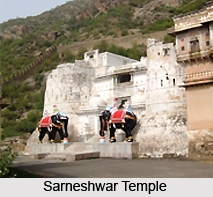 Bhuteshwar Fair - At village Bhutgaon
Bhuteshwar Fair - At village Bhutgaon
Sarneshwar Fair - Near Sirohi
Sheetla Mata Fair - Sirohi Town
Kalkaji Fair - Sirohi Town
Jageshwar Fair - Sirohi Tehsil
Godi Parshavnath Fair - At Mohabat Nagar
Mirpur Parshavnath Fair - At Mirpur
Vaidyanath Fair - At Falvadi village
Brahma ji Fair - At kalandri
Varada Hanuman Fair - At Varada Village
Gautam Ji - Chautila Hill - This fair is of meena community which is devoted to Gautam Rishi, a God of Meena community. The occassion is celebrated on 13 th April of every year. Seeing good oman, the meena dig a pit in the Sukhdi river and on the day Ganga appears and last till the fair is over.
Kambeshwar Mahadev - On Kanakolar hill (Sheoganj Tehsil). The fair is organized by people and dedicated to Lord Shiva. The temple is artistik with culture and heritage.
Vambeshwar Mahadev - Jadoli Veer (Sheoganj Tehsil)
Jagnath Fair - Organized at Sheoganj town
Pabuji Fair - On the river bed of Jawai river mainly of Bhils
Liladhari Mahadev Fair - At Mandar
Jiravala Parshavnath Fair - At Jiraval
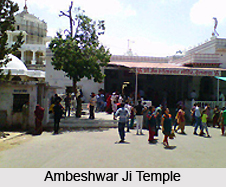 Karrodidwaj Fair - At Karrodidwaj village
Karrodidwaj Fair - At Karrodidwaj village
Jageshwar Mahadev Fair - At Dantrai Hill, in Dantrai village
Sirohi is also famous for its paintings, style of painting is inclined more towards folk. It includes Marwar and Mewar influences along with Mugal fashion, which was rather mixed in Rajasthani culture. Colours of Sirohi paintings are very bright and pure. Early paintings of Sirohi are related to Jain religion. Amongst them, Darshan Chobeesia, Kalikacharya, Kalpasutra, Sangrahani sutra and Upadeshamala Devi Mahatmya etc are the painted manuscripts. The Kalpasutra resembles the earlier central Indian to Gujarat style.
Media
Dainik Bhaskar, Rajasthan Patrika, Lokwarta Samachar and Pratahkal are the popular paper of Sirohi district.



















